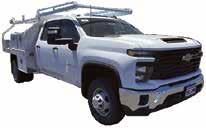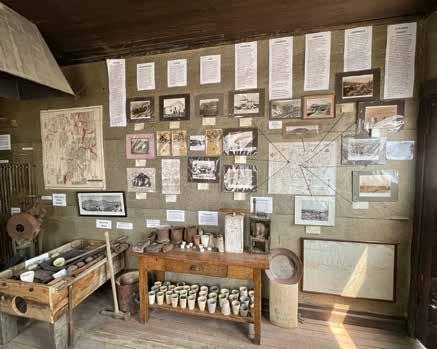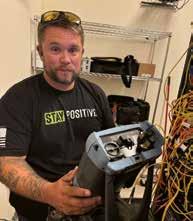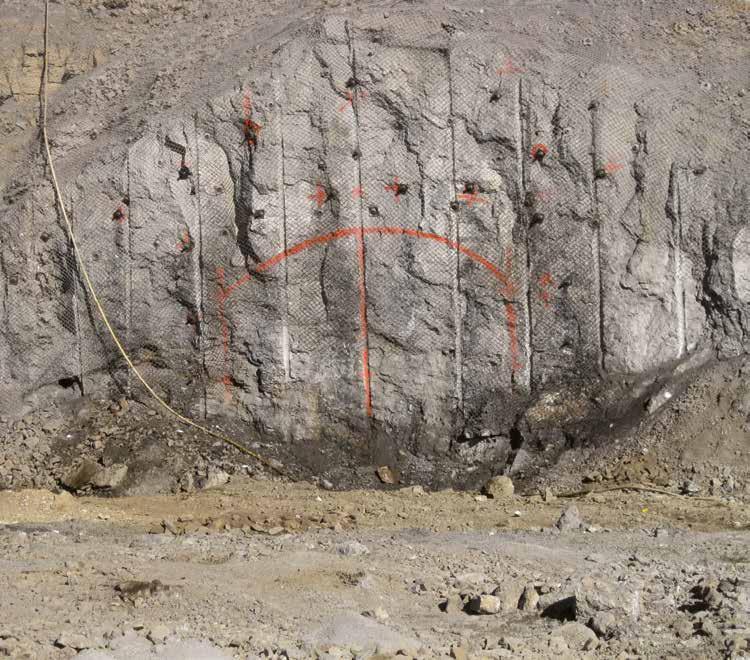


Unionville was one of a handful of bustling mining communities in the 1860s.
See the story beginning on Page 16




Unionville was one of a handful of bustling mining communities in the 1860s.
See the story beginning on Page 16

Publisher: Peter Bernhard
Managing Editor
Special Projects Director: Jen Anderson
Advertising Sales: Ashley Buckingham Cole Castellanos
Advertising Design: Joe Plummer Emily Swindle
Printed by: Oregon Web Press
1022 S. Grass Valley Road, Winnemucca, Nev. 89445
(775) 623-5011
Marzen House Museum’s Mining Display is a National Treasure ............................................................................................4
$1.7 million approved to support mining workforce ............................................................................................6
Discovering Hidden Treasures: Library programs teach about mining ............................................................................................7 Electric Company Start-up supports mining industry ..........................................................................................10
Opinion: Critical mineral mining is essential for Nevada ..........................................................................................14 Meet Heather Nelson, SSR Marigold’s new Community Relations Specialist ..........................................................................................15
Humboldt Museum holds a very rare map of silver mines ..........................................................................................16
Nevada Gold Mines completes large solar farm ..........................................................................................19
Nomads of the Badlands: A tale of early prospecting ..........................................................................................20
Study: Nevadans more interested in gold than stocks ..........................................................................................22
Pioneer ranch, cowboy, mining, and agriculture are celebrated at the Marzen House—an 1874 Italianate style Victorian mansion, the grandest in the area, built by Colonel Joseph Marzen, an early pioneer rancher in the Big Meadows—the area now called Lovelock. Listed on the National Register of Historic Places, and displaying vintage home furnishings and antiquities, the Marzen House was donated in 1980 by Walt and Viola Brinkerhoff to Pershing County and moved 1.5 miles from its original Big Meadow Ranch location, to the present south edge of Lovelock. The Big Meadows Ranch area is also famed as the area along the Emigrant Trail where wagon trains would rest before engaging in the arduous, waterless, crossing of the 40-Mile-Desert.
BY JACK HURSH
Visitors to the Marzen House Museum in Lovelock, Nevada are treated to exhibits of Pershing County’s diverse history. Beautiful displays illustrate the compelling lives of Native Americans living in the Humboldt Valley and utilizing the Lovelock Cave—one of North America’s most treasured archaeological sites. Native artifacts are lovingly displayed and curated by the local Lovelock Paiute Tribe. Pioneer ranch, cowboy, and agriculture are celebrated at the Marzen House—an 1874 Italianate style Victorian mansion, the grandest in the area, built by Colonel Joseph Marzen, an early pioneer rancher in the Big Meadows—the area now called Lovelock. Listed on the National Register of Historic Places, and displaying vintage home furnishings and antiquities, the Marzen House was donated in 1980 by Walt and Viola Brinkerhoff to Pershing County and moved 1.5 miles from its origi-

nal Big Meadow Ranch location, to the present south edge of Lovelock. The Big Meadows Ranch area is also famed as the area along the Emigrant Trail where wagon trains would rest before engaging in the arduous, waterless, crossing of the 40-Mile-Desert.
As you arrive in the parking lot of the Marzen House Museum, you can visit displays of early mining equipment donated by Lovelock residents, like the two stamp mill by Don Meissner,













The funds will be used for instruction provided by NORCAT, a Canada-based company that provides world-class training in the mining sphere, as well as equipment and technology. The program will bring about an estimated 1,150 jobs through employer partners at Lithium Americas, Sawtooth Mining and Nevada Gold Mines.
CARSON CITY, Nev. – The Nevada Governor’s Office of Economic Development (GOED) Board approved $1,693,230 from the Workforce Innovations for a New Nevada (WINN) fund to support three industry-led workforce training programs that will bolster training in logistics, nursing and mining.
This latest round of WINN funding will help operate three programs: , the WINN program has awarded Great Basin College (GBC) $832,230 as part of a larger project to bolster advanced training in the mining sector. The funds will be used for instruction provided by
NORCAT, a Canada-based company that provides world-class training in the mining sphere, as well as equipment and technology. The program will bring about an estimated 1,150 jobs through employer partners at Lithium Americas, Sawtooth Mining and Nevada Gold Mines.
Northeastern Nevada Regional Development Authority (NNRDA) was instrumental in facilitating this relationship with NORCAT.
“I was introduced to the NORCAT team in 2016 and had the privilege of visiting their facilities in Northern Ontario in 2017,” said Sheldon Mudd, execu-
tive director of the Northeastern Nevada Regional Development Authority. “I immediately recognized the potential their training programs had for the mining industry in Nevada and began making the appropriate connections to introduce their unique training model to relevant stakeholders. It is great to finally see a partnership develop between NORCAT and Great Basin College, the premier training institution for Nevada’s mining industry.” The total amount of WINN funds awarded through this biennium period now totals roughly $8.7 million of the $10 million fund.







This summer, the Humboldt County Library invites families to embark on a journey of discovery with the theme “Adventure Begins at Your Library.” To bring this theme to life, we partnered with experts from the American Mining Rights Association (AMRA) and our very own leading geologist, Dawn Leader. This collaboration aimed to educate and inspire families about the fascinating world of geology and the traditional practices of gold panning.
Jeremiah Osgood and Rachel Rosenberg from the AMRA joined us to share their expertise in gold prospecting and mining on public lands. Their hands-on approach provided families with a unique opportunity to learn about the history and techniques of gold panning. They brought a wealth of materials, including Paydirt and gold concentrates, two troughs for kids to practice panning, a dredge, a high banker, a dry washer, a metal detector, and various historical mining artifacts.
Dawn Leader, our esteemed geologist, donated her time to educate families on the role of a geologist. She captivated the audi-
ence with her knowledge and enthusiasm, showcasing an array of rock samples and explaining how to identify different rocks, crystals, and minerals. Leader’s interactive presentation allowed participants to test and examine these samples, deepening their understanding of geology.
The highlight of the event was the outdoor gold panning activity. Families gathered to try their hand at panning for gold, experiencing the thrill of uncovering hidden treasures. Every child received a small bag of any fool’s gold and garnets they discovered, along with a crystal growing home kit, ensuring the adventure continued at home.
The presenters’ dedication and expertise made this program a resound ing success. They not only educated our library families about geology and gold panning but also instilled a sense of wonder and appreciation for the natural world. Through this enriching experi ence, participants discovered that the adventure truly begins at their library.
For any inquiries about Humboldt County Library, please contact the library at (775)623-6388 or visit our website at https:// www.humboldtcountynv.gov/351/Library for more information.













ore cars donated by Frank Chang, Billie Stiff, Pete Fundis, Bob Ernst, the Munk Family, a hoisting engine by Dan Crofoot and Hugh Montrose, and a kiln smelter by C.X. Henry. You can also read historical plaques, erected by the Ancient and Honorable Order of E Clampus Vitus. The museum also pays homage to the coming of the railroad, Chinese laborer tools and artifacts, military history and honors to veterans, famous commercial establishment artifacts from Two Stiffs Selling Gas and many others. In the Marzen House, you can see photos of the visit to Lovelock by Amelia Earhart in 1931, the childhood home of famous Lovelock resident, Edna Purviance, an actress who starred in many silent-era movies with Charlie Chaplin. You may also learn about how Sam Clemens, (Mark Twain), afflicted with gold fever, lived in Unionville for a while and tried to strike it rich, and you might even hear some ghost stories about spirits haunt-
ing the Marzen House.
The Marzen House Museum, along with the Victorian mansion, consists of a campus of several buildings. Along with antique fire trucks and a vintage ambulance, a large display, located in the building called the “Firehouse,” pays particular focus to the history of the Rochester mining district. Sam Clemens was not alone in the pursuit of mineral wealth in these parts as Pershing County can boast having some of the most diverse and extensive mineral commodity resources of any county in Nevada. Pershing County has approximately 45 mining districts, including some of the largest tungsten, antimony, iron, and diatomite mines in Nevada, as well as significant mercury, gold, silver, and copper mines. In 1856. copper ore was discovered at the 56 Mine in the Pershing County area of the Eugene Mountains. However, like Mark Twain (Sam Clemens) wrote in “Roughing It,” most early prospector excitement was over gold and silver, and in the early 1860s, miners were staking claims, and numerous high-grade silver and gold mines were discovered all over the Humboldt Range.


1860s, a group of prospectors, were operating on geologic contacts in a southwest Humboldt Range canyon they named Rochester after their hometown of Rochester, New York. It was not until 1912, that rich silver ores were found in the Rochester district and the busy town site of Rochester sprang up, servicing nearby mines and connected by the narrow gauge Silver Belt Route (Nevada Short Line) railway to Oreana located on the mainline Southern Pacific Railroad.
In the early
The Rochester exhibit, inside the “Firehouse” building, is sponsored by Coeur Rochester, Inc., the modern silver and gold mine that operates at the site of the historical Rochester mining district. The exhibit includes a large diorama of the town site of Rochester in 1916, created by Dale and Rob Darney, mining artifacts and historical photos from Rochester on loan from the Nevada State Museum, a rock drill donated by Don Meissner, a replica wooden mine shaft hoist donated by the BLM, a gold dry wash box donated by Coeur Rochester, Inc., Andrew H. Scott’s assay scale loaned by Paul Davidson. A big thanks is needed to recognize the beautiful exhibit space is the result of many donated hours of sheetrocking by Frank Fisk, display fabrication by David and Bonnie Skoglie, interior paint work by Penny Belanger, and insightful consultation by Dayna Tinsley of G2 Archaeology, and Christine Johnson of the Sparks Heritage Museum.

The museum campus of buildings is lucky enough to have an original, historical building, “The Assay Office,” from the town site of Rochester. The building was moved to Lovelock in 1915, then moved to a second Lovelock location in 1931, where the historical 1880 railroad depot now stands. Then “The Assay office” was moved to the museum campus in 1991. All this moving around of buildings is testimony to the fact that it was common place for buildings to be moved all over the state as one mining camp was playing out and another one was booming. Inside the Assay Office are displays of maps and photos of historical Pershing County mining districts

like Seven Troughs and others, and you will see many assay and mining artifacts like crucibles, scales, drill bits, and business desk, donated by the Frank Fisk Family, and the assayer who owned and used this building Andrew H. Scott and wife Lalla Scott.
The museum campus is also lucky enough to have an original, historical building, “The Blacksmith’s Shop” that was in business from approximately 1912-1929 at Packard. Packard was another town site within the Rochester mining district, only about 2 miles away from Rochester. This small wooden structure had survived all the years at the original site of Packard. In 2020, a project spearheaded by Coeur Rochester, Inc. and the BLM, facilitated the relocation of this building to the museum campus. Blacksmithing tools and artifacts donated by Coeur Rochester, Inc., Frank Fisk, and Web Varnum are on display.


A visitor to the museum will find even more
buildings on campus. The 3-sided metal shed contains more random artifacts, including the LaBelle brothel (now defunct) street sign, and a horse drawn carriage. A circa 1900, railroad station keepers house, relocated from Fernley, will soon display (early 2025) an extensive mineral display collected by Web Varnum, and will also display an array of antique mercantile items.
Visitors prospecting for a fun visit to Lovelock need to stop at the Marzen House Museum. From Native American, mining, railroad, emigrants, agriculture and more, visitors will strike it rich with the exciting history of Pershing County.
BY COLE CASTELLANOS
1st Electric & Automation is a young electrical business that went from a side-hustle to a fullblown electrical contracting business, working in mining, agriculture, and even infrastructure. Dakota Woolever started first 1st Electric while teaching electrical engineering at the Great Basin College, looking to provide additional income. He started small, but his skills allowed him to steadily grow his residential customer-base and see quick success.
In 2022, 1st Electric was joined by two more key players in the growth and development of the company, bringing new skills to the team. In March 2022, Sean Brown brought his own professional experience to the crew along with a new expertise in PLC’s, or programmable logic controllers, which further enhanced their capabilities in automation and more. In November of the same year, Jacob Laird joined the team, which broadened their services with advanced network and data services, which would even find growth of its own.
Wanting to take 1st Electric to the next level, Dakota and his team dove into the industrial market, and took a job with Cyanco, doing maintenance in their solids plant fixing pressure transmitters and troubleshooting the issues within some of their automated systems, something they are quite good at. They didn’t stop there though, and moved into the agricultural scene, working with AgriLines, providing irrigation solutions to many of our local farmers as well.

the drive to deliver results that exceed expectation, and that dedication to excellent results is what has empowered their growth and success.
The company was becoming a great success, and as it grew, so did their presence. 1st Electric has already established a presence across multiple industries, and has partnered with Cyanco, US Silica, Agri-Lines Irrigation, I-80 Gold Corp, Hecla Mining Company, Nevada Gold Mines, SSR Mining, Marigold, Cyrq Energy, Open Mountain Energy, and even more noteworthy names across Northern Nevada, providing mining support, manpower support, mining maintenance, and troubleshooting. This presence amongst so many different industries gave them
They provide a special niche in mining maintenance, not only for their set of skills, but also in the way they go about their work. Because 1st Electric is a third party to these mines as contractors, they go on-site to work a specific job and get paid for that job, and then leave. This is a major benefit to many mines, especially in Small Mine Development, where it can be majorly cost effective to hire skilled technicians by-job, rather than having full-time positions for problems that do not always arise. This gives 1st Electric the ability to cover a large range of clients, giving them an incredibly diverse clientele.
Contracting has allowed 1st Electric and its crew of technicians to grow quickly and gain a wide range of experience in multiple industries, giving them an insight into different environments, problems, processes, and solutions. This wide range of possibilities for what the average workday looks like as a contractor shows you the importance of learning on the go. Dakota and his team understand that different operations will have different processes, equipment, problems, and solutions, and they pride themselves in taking their time with each client to better understand their processes, equipment, and issues so they can bring cus-

tomized solutions to each client.
1st Electric & Automation provide mining support, manpower support, and mining maintenance, but this isn’t where they’re services stop. A common issue in mining is power, due to the remote locations of these mines. Power lines become a necessity, and they are not always a viable option. 1st Electric aims to solve this issue by bringing alternative and renewable energy into the industry. Not only can renewable energy majorly offset costs but can also bring in extra power using solar grids, geothermal power, wind power and more. 1st Electric is ambitious in these alternate forms of energy and shows excitement in the benefits they provide.
1st Electric has found fast growth due to their ambitions, but they won’t stop here. Brandon Robb joined their team of stakeholders as Electrical Engineering and Government Services manager. Brandon Robb works behind the scenes, and focusses on what kind of infrastructure and government related work they can do to broaden their horizons. This has allowed them to accomplish a feat such as getting shortlisted for government projects, meaning they’ve made it through a round of applicants in the intensive screening process that
you must go through to get hired for government jobs of this industry. Aside from being shortlisted, this side of work has already given them opportunities across the United States and has allowed them to travel for various projects, one of which brought them all the way to Perry Point Maryland.
At the Perry Point VA, Dakota and his team gave the veterans there some basic electoral training. They went over things like electrical theory, AC/DC Circuit fundamentals, and of course safety. Dakota spoke fondly about this experience, and he has expressed that he is ambitious to bring more education regarding this line of work to Winnemucca and bring more hands-on training and on-the-job experience.
Dakota continued to teach at the Great Basin College until he made the jump to focus all of his time on 1st Electric in December of 2023. After only 3 and a half years, 1st Electric has established their presence in the mining industry and has formed good relationships with many of their clients. This success has been driven by their passion and ambition to become the foremost electrical company. They’ve set their sights high, and through their commitment to building a culture of innovation and collaboration, they are dedicated to seeing their vision realized.


By Dylan Gallagher
As the district representative of Operating Engineers Local 3 in Northern Nevada and a member of this union, I know firsthand the importance of the mining industry to our families and communities. We depend on jobs in the mining industry not to just have a future in which we live comfortably, but a future in which our planet isn’t being destroyed by climate change. Mining is crucial for both. I represent hundreds of mining members who feel the same way.
It’s not an exaggeration to say that rural towns throughout Nevada wouldn’t exist without mining. Some may say that the mining industry only benefits corporations, but the mining worker and his or her community needs the industry to actually survive. Critical mineral mining is the backbone of our local economy, and the benefits we get from our union work enable us to raise our families here in Nevada.
I know mining doesn’t always have support from certain environmental activists,
but they miss its advantages for our local communities and the climate. Mineral mining is critical for combating climate change.
Critical minerals are a key part of clean energy technology. The lithium extracted in Nevada is essential for lithium-ion batteries that power electric cars and clean energy storage technology, like solar cells. The only way for our country to continue to lead the rest of the world into the clean energy future is through mining critical minerals.
I care about our planet’s future, as do my colleagues. I want to be part of the generation that puts us on a path to a sustainable future. And it frustrates me to see so many discount the work our members provide to make that a reality. Anyone who condemns critical mineral mining has a fundamental misunderstanding of one of our most powerful tools to combat climate change.
Our clean energy economy, our working families and our rural communities in Nevada depend on mining operations, and our representatives in Congress have a respon-
sibility to clear the roadblocks in its path.
There is currently legislation being proposed in Congress to do just that. Last year, a federal court decided mining companies are required to prove that all their operations are on mineral-rich land. This makes little sense. Not all parts of mining operations can or should be on mineral-rich land — mining-support activities such as waste rock storage, processing, vehicle storage, and administrative offices are all a part of mining operations, and forcing mining companies to use mineral-rich land for these activities is wasteful and inefficient. Because of the Rosemont decision, many new mine projects in Nevada will be delayed, holding up jobs and leaving workers and their families hanging.
That’s why the Mining Regulatory Clarity Act, led by Nevada’s Sen. Catherine Cortez Masto, is so important. This legislation would reverse the harmful Rosemont decision and help Nevada mining projects create and protect more good-paying jobs. This



bill does not allow unrestricted access to public lands, does not allow mining activity in national parks or other protected areas, and does not in any way diminish mining companies’ obligations to tribes or to the environment. We already have strict regulations for our mining operations, and I don’t want to see us lose out on critical mineral mining to countries such as China, whose labor and environmental practices are abysmal. Those jobs should be here in Nevada, and this law will help ensure the future of our operations.
When people think about mining, they often think of it as a nameless and faceless institution. In reality, the mining industry represents thousands of workers and families across our country. Mining critical minerals has given us good-paying jobs with great benefits, it strengthens our rural economies and it’s helping the United States lead the rest of the world into the clean energy future. This country needs to continue supporting mining operations for the sake of our families, our communities and our planet.
Dylan Gallagher is the district representative of Operating Engineers Local 3 in Northern Nevada.









One of the most interesting items in Humboldt Museum’s collection is the 1863 Milleson & Washburn’s Map of the Celebrated Humboldt Silver Mines. It measures approximately 31” by 49”, but folds to fit nicely within its 4.5” by 7” hardbound cover. With only a few known copies still in existence, it is a very rare map. Museum staff and researchers use a digital copy as a resource, allowing the original to stay consistently tucked away from light and dust. The map is full color and illustrates a time when mining was just beginning in North Central Nevada.
As the story goes, in 1860, ledges of quartz were discovered within the Humboldt Range, specifically at Humboldt Canyon, by passing Salt Lake Route stage driver, Louis Barbeau (Babo). In May of that year, he and a man named Frank Johnson traveled up the canyon to assess the find and collect specimens. They wound up spending three weeks in the canyon. The cause due to Barbeau falling ill and needing time to convalesce, before
making their way into Virginia City to announce their discovery. The time spent in the canyon allowed the men an opportunity to not only find


and collect specimens, but also time enough to establish a mining district with rules and structure that would help facilitate order when word of their discovery got out and the boom came. Within one year, Humboldt City was established in Humboldt Canyon with a population of 469, while other canyons within the range started to see similar activity. In addition to the growing number of mining districts within the Humboldt Range, several named boom towns were quick to spring up. Some were more well-known and longer-lasting than others. By 1863, there were ten mining districts and eight towns developed enough to be acknowledged on Milleson & Washburn’s Map of the Celebrated Humboldt Silver Mines. Those towns were Humboldt City, Prince Royal, Santa Clara, Star City, Argentum City, Stevensville, Mineral Point and Unionville.
Of interest particularly to the researcher-type, are the



detailed names of the ledges and companies within the districts acknowledged on this map. In certain instances, when the location of the district book is known, researchers are able to cross reference the notes in those districts books to the information represented on this map. Recently, the handwritten-1860s Prince Royal District Book, located at the Humboldt County Recorder’s Office, was photographed and indexed thanks to a dedicated researcher, donor and volunteer.
Milleson & Washburn’s Map of the Celebrated Humboldt Silver Mines also illustrates routes used for travel and transportation. Among the noted are the California Trail (Emigrant Road); the Humboldt Canal Route, a project which never came to fruition despite the investments; the Echo Canyon Trail to Buena Vista Canyon, where Unionville was established; and Wagon Roads from Virginia City to the Humboldt Range. It’s interesting to think about the people traveling those road and trails in the 1860s, such as Samuel Clemens, (aka Mark Twain), who unsuccessfully prospected in the Unionville area during the winter of 1861-1862.
Humboldt Museum recognizes the rich mining history of North Central Nevada and the continued value of the mining industry as we move into the future. The Milleson & Washburn’s Map of the Celebrated Humboldt Silver Mines is only one of the many objects found in the museum’s growing collection that helps us to understand the development of mining in this area. We hope you’re able to visit soon to see some of the other items pertaining to historical mining actives in and around North Central Nevada.



Nevada Senator Jacky Rosen and Barrick President and CEO Mark Bristow (center) celebrate the completion of the 200-megawatt solar power plant at Nevada Gold Mines
ELKO — The Barrick-operated Nevada Gold Mines (NGM), a joint venture with Newmont Corporation, has completed the construction of the second and final phase of a 200-megawatt solar power plant, which will have the capacity of producing 17% of NGM’s annual power demand while realizing an equivalent emissions reduction of 234 Kt of carbon dioxide per year.
Speaking at a ribbon-cutting ceremony at NGM’s TS Solar Power Plant today, which was attended by Senator Jacky
Mining Ad.1/4.qxp_Layout 1 9/19/24 12:26 PM Page 2




·
·
·
·

pipe 3/4” to 6”
In the harsh and unyielding landscapes of the early 20th-century Mojave Desert, one family’s relentless quest for gold emerges as a riveting tale of perseverance and adventure. “Nomads of the Badlands,” the latest work by Walt Wilhelm, chronicles the extraordinary journey of Sherman and Dora Wilhelm and their seven children as they traverse the rugged terrain of Arizona, Nevada, and California in pursuit of their fortune.
Released recently, “Nomads of the Badlands” offers a rich, autobiographical account of the Wilhelms’ desert escapades between 1912 and 1915. The book provides a detailed narrative of their travels in era cars across desolate stretches where water sources were few and far between. The Wilhelms’ journey was fraught with challenges—from navigating treacherous sands and improvising makeshift roads to encountering colorful desert characters including prospectors, bootleggers, and cowboys.
Walt Wilhelm’s second book and a sequel to his earlier work, Last Rig To Battle Mountain, brings to life the hardships and triumphs of early desert prospecting. As Pat Schoffstall of the Mojave River Valley Museum notes, “This is a good book, full of local history and familiar names. It reads like a visit with old friends and I had a hard time putting it down.” The Wilhelms’ adventure saw them prospecting in notable locations such as Siegelman, Oatman, and Kingman, as well as crossing the Colorado River and exploring the remote areas of Searchlight and El Dorado Canyon.
The family’s perseverance is evident in their makeshift approach to life and prospecting in the desert. They faced the elements head-on, camping, hunting, and swimming in areas that would later become the Mojave National Preserve. Their story includes vivid details of the desert’s mining towns, ghost towns, and the early days of the Old National Trails Road, a precursor to the iconic Route 66.
Walt Wilhelm, born in Trenton, Missouri, in 1893, was a multifaceted individual with a passion for exploration and storytelling. As a civilian blacksmith for the U.S. Marine Corps, Wilhelm’s expertise extended beyond metallurgy to off-road vehicles, photography, and amateur archaeology. His first book, Last Rig To Battle Mountain, received acclaim for its engaging narrative and historical significance. “Nomads of the Badlands” builds upon this legacy, offering a compelling account of his family’s pioneering spirit.
Wilhelm’s adventurous spirit extended to his involvement in media and entertainment. He and his brother Ken Wilhelm featured in films produced by Paramount Pictures and Grantland Rice Productions, showcasing off-road driving and archery trick shooting. Their contributions to off-road vehicle innovation,

including vehicles like The Prowler and Leaping Lena, were celebrated in magazines such as Mechanics Illustrated and Popular Science. The Wilhelms were inducted into the California Archery Hall of Fame in 1978, underscoring their impact on both archery and desert exploration.
The book has garnered praise for its vivid portrayal of early desert life and the Wilhelms’ indomitable spirit. Darelyn Casebier, Treasurer of the Mojave Desert Heritage and Cultural Association (MDHCA), remarked, “The Wilhelm family story is so compelling, so uniquely American, that anyone with a sense of adventure and a wandering spirit will find it extremely enjoyable.” Jay Barrs, Archery Olympian Gold Medalist, added, “The more you read, the more impressed, inspired, and captivated you will become with this family.”
“Nomads of the Badlands” is available in hardback, softback, and eBook formats. The hardback edition, featuring a dust cover that complements Wilhelm’s previous book, can be purchased through IngramSpark, while the softback and eBook versions are available on Amazon.The book not only serves as a testament to the Wilhelms’ enduring legacy but also offers readers a detailed glimpse into the history and adventure of early 20th-century desert prospecting. For those interested in the rugged and captivating history of the Mojave Desert, “Nomads of the Badlands” is an essential read, embodying the spirit of exploration and resilience that defined a bygone era.

Rosen and the Department of Energy’s Heidi Miller, Barrick president and chief executive Mark Bristow said the solar facility would reduce NGM’s total annual greenhouse gas emissions by 8% against a 2018 baseline.
“The solar facility is one of many initiatives to reduce our reliance on carbon-based electricity sources. We are also in the process of modifying NGM’s TS Power Plant to use cleaner burning natural gas as a fuel source. Additionally, in 2023, we began introducing electric vehicles to our light vehicle fleet which included the required charging infrastructure in Elko and at the main mines Carlin, Cortez, Turquoise Ridge and Phoenix as well as here at the TS Power Plant,” Bristow said.

The solar facility has the capacity to produce 17% of the annual power demand at Nevada Gold Mines.
With the second phase of the TS Solar Power plant adding another 100MW of energy-producing capacity to NGM’s operations in April this year, our carbon reduction efforts continue at the TS Power Plant where we are converting to co-fire capability and furthering studies into geothermal energy sources.
NGM was also recently awarded $95 million in funding from the US Department of Energy to develop additional solar facilities with battery energy storage systems (BESS) at the Turquoise Ridge and Cortez mine sites. These will serve as a secondary power source, mitigating the impacts of power grid disruption and enhancing renewable energy consumption during off-peak hours.







A new analysis from U.S. Money Reserve reveals a marked regional preference for gold over stocks in the United States, with Nevada standing out in particular. The study, which examined Google Trends data from 2019 to 2024, shows a substantial interest in gold across the western states, notably within the Mountain West and Alaska regions.
This growing interest in gold comes amid a broader trend driven by global economic uncertainties and heightened geopolitical risks. Since the COVID-19 pandemic, gold has seen renewed interest as investors seek stability amid market volatility. The precious metal’s price surged to record highs in August 2020 and has continued to perform robustly in 2024, buoyed by factors including potential interest rate cuts and increased central bank purchases.

In the latest Gallup survey, gold was identified as a top long-
term investment choice by 18% of Americans, trailing only behind real estate and stocks. This popularity underscores gold’s appeal as a stable asset compared to other investment options such as savings accounts, CDs, bonds, and cryptocurrencies.
For Nevada, the data highlights a significant regional trend: internet searches for “gold prices” have surpassed searches for “stock prices” by the third largest margin among U.S. states. This indicates a pronounced preference for gold investments among Nevadans compared to the broader national trend. Overall, while gold-related searches have increased across 44 states over the past five years, the data underscores a particularly strong inclination towards gold in Nevada and other western states. This trend reflects a continued confidence in gold’s role as a secure investment amid ongoing economic uncertainties.






In 2023, Nevada Gold Mines invested $3.1 Billion in economic contributions to the state of Nevada. We are committed to creating long-term value for all of Nevada.

